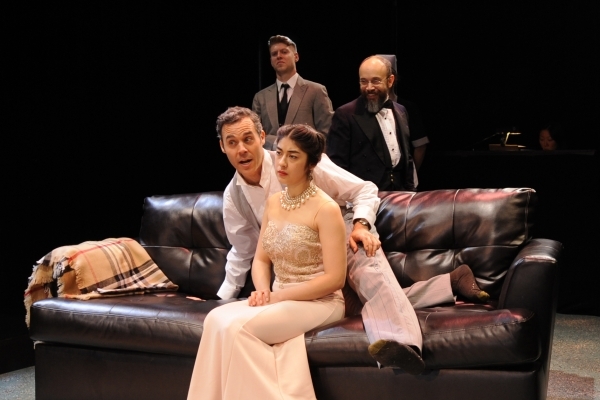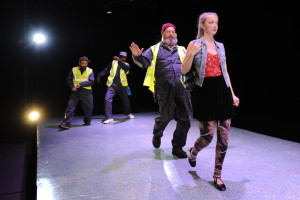
Alexander Burns and his troupe, grounded in a progressive approach to classic works, make magic in the Mount Airy section of Philadelphia. Quintessence has staged some of this town’s most vibrant theatrical offerings. Now they’re trying something different: A Musical. Director Alex Burns wrote, “During this crucial moment of self-reflection on the responsibilities of powerful men in their treatment of and assistance in the empowerment of women, it is a thrilling opportunity to return to Lerner and Loewe’s romantic musical adaptation of George Bernard Shaw’s timeless comedy of manners.”
My initial reaction on hearing that MY FAIR LADY was on Quintessence’s docket was, “What? But they’re a classics house!” However, right on the heels of that notion, I thought of GB Shaw’s Pygmalion that goes back to the Greeks, a classic for sure. And then the 1938 Wendy Hiller/ Leslie Howard Pygmalion. Lerner & Loewe MY FAIR LADY debuted on Broadway in 1956 with Rex Harrison and Julie Andrews. It ran for over 2700 performances. At London’s Drury Lane Theatre it ran for years. Then there’s the Warner Brothers version, George Cukor’s adaptation. The story truly is a classic. And it has marvelous songs!
Tucked away deep in the old stripped-down Sedgwick Movie Theater on Germantown Avenue, spirited pianists (Music Director Christopher Ertelt and Amanda Morton) play energetically at opposite ends of a long runway that serves as a stage and bisects the room. [The two-piano version of this show has been a thing at a few theaters, including McCarter three years ago. But this production is not a copy of others.]
MY FAIR LADY, in brief, is the story of a linguist, Professor Henry Higgins, and a poor young Cockney woman, Eliza. She asks him to teach her correct English so that she can open a flower shop. He takes her on as a pupil. On a bet, the professor turns the street urchin flower-seller into a woman who can pass as royalty. The romance part of MY FAIR LADY is a bit of a conundrum. Young Freddy is desperately in love with Eliza. She encourages him to stop talking about it and show it, although she doesn’t seem all that keen. Freddy sings the lovely “On the Street Where You Live,” but fades out of the picture as other concerns take center stage.

Leigha Kato delivers it all— clear singing and a frightened, poised, soft, and feisty Eliza Doolittle. We’ve seen that Gregory Isaac can do villains, i.e., Bassanes (The Broken Heart) and Faustus (Doctor Faustus). His Henry Higgins, although arrogant and clueless about women, is a paper villain. Egotistical and amusing, he conceals a softer side. Robust Bradley Mott pulls his weight, especially as the comical Alfred P. Doolittle. Doug Hara’s steady Colonel Pickering provides a sounding board and civilizing influence. Marcia Sauder’s Mrs. Higgins is the perfect grounded, no-nonsense mum for the peevish professor. She also plays sensible Mrs. Pearce, Higgins’s housekeeper and solace to Eliza. Young Freddy (Lee Cortopassi) has a lovely voice.
It’s exciting. The production feels intimate and very fresh. The ensemble can really sing and they must be a choreographer’s dream (Kaki Burns). They waltz decorously, execute exuberant street dances, tap, Mummers’ Strut, you name it. The whole company is terrific and dance captain Rakeem Lawrence is a joy to watch. Doug Greene’s quick moveable setups alter locations on the fly, and subtleties of David A. Sexton’s lighting affect changing atmospheres. With her beautiful, updated, elegant, sometimes casual, even crazy costumes, Christina Bullard works the looks.
This contemporary take is a new look at old times and an old look at new times. Undercurrents of societal problems run through the work providing a touch of heft. Reverberations of old class systems bump into present versions of the same sort of thing. It is still the case that the way people speak can keep them on the lower rung. (Unless they’re the President. Sorry.) But the idea of what is valuable in speech is changing. Empowerment of women, while better than it once was, still remains a challenge. Bernard Shaw, a famed Socialist, championed the emancipation of women. Three years before Pygmalion he penned Press Cuttings, a satirical theater piece specifically for the Women’s Suffrage Movement. Initially it was shut down by censors– 1909’s guardians of patriarchy.
A big part of MY FAIR LADY’s story turns on how Eliza blames Professor Higgins. She says he ruined her when he transformed her from a guttersnipe and raised her above her class. She cries, what is she fit for now? But within the construct of the play this is an odd complaint. Eliza asked for tutoring in the language so that she could open a flower shop for the carriage trade. And, due to a male chauvinist’s help, she comes into her own. She could now have a real flower shop. However, although he helped her to become exactly what she wanted to be, she doesn’t see it that way. Eliza has metamorphosed. She wants his respect. Higgins has been boorish and he has used her as a pawn, amusing himself with a bet and then taking all the credit for her success. But really, with all she’s gained, including self-respect, it seems like wasted angst. On Higgins’s side, although he sees her as an ingrate, he can’t get her out of his head. Much of the show’s poignancy rests in Henry Higgins.
Finally, there’s always speculation about the ending. Shaw made his choice very clear. The Lerner & Loewe team went their way in a kind of dodge. I was eager to see which one Alexander Burns would go for, the Lerner & Loewe’s ending or the Bernard Shaw ending.
You don’t need Christmas decorations to liven this up. With the company’s talent, high standards and commitment to diversity, Quintessence Theatre’s MY FAIR LADY is a jubilant mix of beautiful music and songs, dancing, magic, social politics… and elocution. It’s a splendid show, a holiday gift.
[Sedgwick Theater, Germantown Avenue, Mount Airy] November 15-December 17, 2017; quintessencetheatre.org

Kathryn, what a wonderful review. One of my best friends invited me to see the first show after opening night–as a surprise gift. I didn’t know until we arrived at the Sedgwick Theatre. 🙂 She could not have chosen a better present.
Like you, I was surprised, initally, that Alex Burns, the director of the much talked about Quintessence theater with its classical repertoire, would actually tackle MY FAIR LADY–out of all musicals. Your review nailed it: one of the best productions of that Shavian masterpiece, set to music, with many artists contributing to its success, without letting it become a mothballed production of the finest of the finest furniture and costumes that money could buy.
The Weinsteinian references, the vulgarity of certain greedy, creepy creeps in the US, all came through in subtle, yet powerful ways. May your classy review of this fantastic production fill each seat. That afternoon house on my birthday was sold out.
And Pygmalion behind that painter’s cloth on Germantown Avenue smiled.
Henrik Eger, editor
http://www.DramaAroundTheGlobe.com
Henrik, Thank you for your considered –and considerate– response to my review of My Fair Lady. And, hey, Happy Birthday!